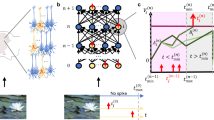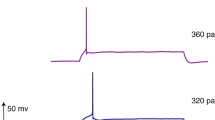Abstract
Spiking neural networks (SNNs) are mimicking computationally powerful biologically inspired models in which neurons communicate through sequences of spikes, regarded here as sparse binary sequences of zeros and ones. In neuroscience it is conjectured that time encoding, where the information is carried by the temporal position of spikes, is playing a crucial role at least in some parts of the brain where estimation of the spiking rate with a large latency cannot take place. Motivated by the efficiency of temporal coding, compared with the widely used rate coding, the goal of this paper is to develop and train an energy-efficient time-coded deep spiking neural network system. To ensure that the similarity among input stimuli is translated into a correlation of the spike sequences, we introduce correlative temporal encoding and extended correlative temporal encoding techniques to map analog input information into input spike patterns. Importantly, we propose an implementation where all multiplications in the system are replaced with at most a few additions. As a more efficient alternative to both rate-coded SNNs and artificial neural networks, such system represents a preferable solution for the implementation of neuromorphic hardware. We consider data classification tasks where input spike patterns are presented to a feed-forward architecture with leaky-integrate-and-fire neurons. The SNN is trained by backpropagation through time with the objective to match sequences of output spikes with those of specifically designed target spike patterns, each corresponding to exactly one class. During inference the target spike pattern with the smallest van Rossum distance from the output spike pattern determines the class. Extensive simulations indicate that the proposed system achieves a classification accuracy at par with that of state-of-the-art machine learning models.







Similar content being viewed by others
Explore related subjects
Discover the latest articles and news from researchers in related subjects, suggested using machine learning.Data availability
The datasets utilized during the current study are available in public repositories.
References
Dasgupta S, Stevens CF, Navlakha S (2017) A neural algorithm for a fundamental computing problem. Science 358(6364):793–796. https://doi.org/10.1126/science.aam9868
Eichler K et al (2017) The complete connectome of a learning and memory centre in an insect brain. Nature. https://doi.org/10.1038/nature23455
Ryali C, Hopfield J, Grinberg L, Krotov D (2020) Bio-inspired hashing for unsupervised similarity search. In: International conference on machine learning, pp 8295–8306 PMLR
Jankowski M, Gündüz D, Mikolajczyk K (2020) Joint device-edge inference over wireless links with pruning. In: 2020 IEEE 21st international workshop on signal processing advances in wireless communications (SPAWC), pp 1–5 IEEE
Cherubini G, Jelitto J, Venkatesan V (2016) Cognitive storage for big data. Computer 49:43–51
Cortes C, Vapnik V (1995) Support-vector networks. Mach Learn 20(3):273–297
Schmidhuber J (2015) Deep learning in neural networks: an overview. Neural Netw 61:85–117
Strubell E, Ganesh A, McCallum A (2019) Energy and policy considerations for deep learning in nlp. arXiv preprint arXiv:1906.02243
Devlin J, Chang M-W, Lee K, Toutanova K (2018) Bert: Pre-training of deep bidirectional transformers for language understanding. arXiv preprint arXiv:1810.04805
Ghosh-Dastidar S, Adeli H (2009) Third generation neural networks: Spiking neural networks. Adv Comput Intell, pp 167–178 Springer
Ponulak F, Kasinski A (2011) Introduction to spiking neural networks: Information processing, learning and applications. Acta Neurobiol Exp 71(4):409–433
Zambrano D, Nusselder R, Scholte HS, Bohte S (2017) Efficient computation in adaptive artificial spiking neural networks. arXiv:1710.04838
Boybat I et al. (2018) Neuromorphic computing with multi-memristive synapses. Nat Commun
Sebastian A et al. (2018) Tutorial: Brain-inspired computing using phase-change memory devices. J Appl Phys 124
Garain A, Basu A, Giampaolo F, Velasquez JD, Sarkar R (2021) Detection of covid-19 from ct scan images: a spiking neural network-based approach. Neural Comput Appl 33(19):12591–12604
Luo Y et al (2022) Conversion of siamese networks to spiking neural networks for energy-efficient object tracking. Neural Comput Appl 34(12):9967–9982
Toğaçar M, Ergen B, Cömert Z (2021) Detection of weather images by using spiking neural networks of deep learning models. Neural Comput Appl 33(11):6147–6159
Liu J, Jiang D, Luo Y, Qiu S, Huang Y (2021) Minimally buffered deflection router for spiking neural network hardware implementations. Neural Comput Appl 33(18):11753–11764
Hu S et al (2021) Quantized stdp-based online-learning spiking neural network. Neural Comput Appl 33(19):12317–12332
Cao Z et al (2015) Spiking neural network-based target tracking control for autonomous mobile robots. Neural Comput Appl 26(8):1839–1847
Jimenez-Romero C, Johnson J (2017) Spikinglab: modelling agents controlled by spiking neural networks in netlogo. Neural Comput Appl 28(1):755–764
Courbariaux M, Hubara I, Soudry D, El-Yaniv R, Bengio Y (2016) Binarized neural networks: training deep neural networks with weights and activations constrained to+ 1 or \(-\)1. arXiv preprint arXiv:1602.02830
Lin M et al (2020) Rotated binary neural network. Adv Neural Inf Process Syst 33:7474–7485
Liu Z, Shen Z, Savvides M, Cheng K-T (2020) Reactnet: Towards precise binary neural network with generalized activation functions. In: European conference on computer vision, pp 143–159 Springer
Wang Y, Yang Y, Sun F, Yao A (2021) Sub-bit neural networks: learning to compress and accelerate binary neural networks. In: Proceedings of the IEEE/CVF international conference on computer vision, pp 5360–5369
Lin M, et al. (2021) Siman: Sign-to-magnitude network binarization. arXiv preprint arXiv:2102.07981
Bulat A, Tzimiropoulos G (2019) Xnor-net++: Improved binary neural networks. arXiv preprint arXiv:1909.13863
Liu Z et al. (2018) Bi-real net: Enhancing the performance of 1-bit cnns with improved representational capability and advanced training algorithm. In: Proceedings of the European conference on computer vision (ECCV), pp 722–737
Xu Z, et al. (2021) Recu: Reviving the dead weights in binary neural networks. Proceedings of the IEEE/CVF international conference on computer vision, pp 5198–5208
Bellec G et al (2020) A solution to the learning dilemma for recurrent networks of spiking neurons. Nat Commun 11(1):1–15
Zenke F, Ganguli S (2018) Superspike: Supervised learning in multilayer spiking neural networks. Neural Comput 30(6):1514–1541
Comşa I-M, et al. (2021) Temporal coding in spiking neural networks with alpha synaptic function: learning with backpropagation. In: IEEE transactions on neural networks and learning systems
Rueckauer B, Lungu I-A, Hu Y, Pfeiffer M, Liu S-C (2017) Conversion of continuous-valued deep networks to efficient event-driven networks for image classification. Front Neurosci 11:682
Huh D, Sejnowski TJ (2017) Gradient descent for spiking neural networks. arXiv preprint arXiv:1706.04698
Gardner B, Sporea I, Grüning A (2015) Learning spatiotemporally encoded pattern transformations in structured spiking neural networks. Neural Comput 27(12):2548–2586
Hunsberger E, Eliasmith C (2015) Spiking deep networks with lif neurons. arXiv preprint arXiv:1510.08829
Woźniak S, Pantazi A, Bohnstingl T, Eleftheriou E (2020) Deep learning incorporating biologically inspired neural dynamics and in-memory computing. Nature Mach Intell 2(6):325–336
Neftci EO, Mostafa H, Zenke F (2019) Surrogate gradient learning in spiking neural networks: bringing the power of gradient-based optimization to spiking neural networks. IEEE Signal Process Mag 36(6):51–63
Bohte SM (2011) Error-backpropagation in networks of fractionally predictive spiking neurons. In: International Conference on Artificial Neural Networks, pp 60–68, Springer
Hubel DH, Wiesel TN (1959) Receptive fields of single neurones in the cat’s striate cortex. J Physiol 148(3):574–591
Fabre-Thorpe M, Richard G, Thorpe SJ (1998) Rapid categorization of natural images by rhesus monkeys. Neuroreport 9(2):303–308
Kubke MF, Massoglia DP, Carr CE (2002) Developmental changes underlying the formation of the specialized time coding circuits in barn owls (tyto alba). J Neurosci 22(17):7671–7679
Gollisch T, Meister M (2008) Rapid neural coding in the retina with relative spike latencies. Science 319(5866), 1108–1111
Johansson RS, Birznieks I (2004) First spikes in ensembles of human tactile afferents code complex spatial fingertip events. Nat Neurosci 7(2):170–177
Bohte S, Kok J, Poutré H (2001) Error-backpropagation in temporally encoded networks of spiking neurons. Neurocomputing 48:17–37. https://doi.org/10.1016/S0925-2312(01)00658-0
Mostafa H (2018) Supervised learning based on temporal coding in spiking neural networks. IEEE Trans Neural Netw Learn Syst 29(7):3227–3235. https://doi.org/10.1109/TNNLS.2017.2726060
Gerstner W, Kistler WM, Naud R, Paninski L (2014) Neuronal dynamics: from single neurons to networks and models of cognition. Cambridge University Press, Cambridge
Marimuthu C, Thangaraj P, Ramesan A (2010) Low power shift and add multiplier design. arXiv preprint arXiv:1006.1179
Sjöström PJ, Rancz EA, Roth A, Häusser M (2008) Dendritic excitability and synaptic plasticity. Physiol Rev
Stanojevic A, Cherubini G, Moraitis T, Sebastian A (2020) File classification based on spiking neural networks. In: 2020 IEEE international symposium on circuits and systems (ISCAS), pp 1–5 IEEE
van Rossum MC (2001) A novel spike distance. Neural Comput 13(4):751–763
Gardner B, Sporea I, Grüning A (2015) Encoding spike patterns in multilayer spiking neural networks. arXiv preprint arXiv:1503.09129
Venkatesan V, Lehinevych T, Cherubini G, Glybovets A, Lantz M (2018) Graph-based data relevance estimation for large storage systems. 2018 IEEE international congress on big data (BigData Congress), pp 232–236. IEEE
Simons G, Johnson NL (1971) On the convergence of binomial to poisson distributions. Ann Math Statist 42(5):1735–1736. https://doi.org/10.1214/aoms/1177693172
Deng L (2012) The mnist database of handwritten digit images for machine learning research. IEEE Signal Process Mag 29(6):141–142
Xiao H, Rasul K, Vollgraf R (2017) Fashion-mnist: a novel image dataset for benchmarking machine learning algorithms. arXiv preprint arXiv:1708.07747
Greene D, Cunningham P (2006) Practical solutions to the problem of diagonal dominance in kernel document clustering. In: Proceedings of the 23rd international conference on machine learning (ICML’06), pp 377–384 ACM Press
Krizhevsky A, Hinton G, et al. (2009) Learning multiple layers of features from tiny images
Kingma DP, Ba J (2014) Adam: a method for stochastic optimization. arXiv preprint arXiv:1412.6980
Srivastava N, Hinton G, Krizhevsky A, Sutskever I, Salakhutdinov R (2014) Dropout: a simple way to prevent neural networks from overfitting. J Mach Learn Res 15(1):1929–1958
Goodfellow I, Bengio Y, Courville A (2016) Deep learning. MIT Press. http://www.deeplearningbook.org
Manning C, Schutze H (1999) Foundations of statistical natural language processing. MIT press
Qaiser S, Ali R (2018) Text mining: Use of tf-idf to examine the relevance of words to documents. Int J Comput Appl, 181. https://doi.org/10.5120/ijca2018917395
Geifman YG (2018) https://github.com/geifmany/cifar-vgg
Zhang A, Zhou H, Li X, Zhu W (2019) Fast and robust learning in spiking feed-forward neural networks based on intrinsic plasticity mechanism. Neurocomputing 365:102–112
Zhao D, Zeng Y, Zhang T, Shi M, Zhao F.Glsnn (2020) A multi-layer spiking neural network based on global feedback alignment and local stdp plasticity. Front Comput Neurosci 14
Ranjan JAK, Sigamani T, Barnabas J (2020) A novel and efficient classifier using spiking neural network. J Supercomput 76(9):6545–6560
She X, Long Y, Mukhopadhyay S (2019) Fast and low-precision learning in gpu-accelerated spiking neural network. In: 2019 Design, automation and test in Europe conference and exhibition (DATE), pp 450–455 IEEE
Volobuev AN, Petrov ES et al (2011) Analog-to-digital conversion of information in the retina. Nat Sci 3(01):53
Bellec G, Salaj D, Subramoney A, Legenstein R, Maass W (2018) Long short-term memory and learning-to-learn in networks of spiking neurons. Adv Neural Inf Process Syst 31
Farsa EZ, Ahmadi A, Maleki MA, Gholami M, Rad HN (2019) A low-cost high-speed neuromorphic hardware based on spiking neural network. IEEE Trans Circuits Syst II Exp Briefs 66(9):1582–1586
Horowitz M (2014) 1.1 computing’s energy problem (and what we can do about it). In: 2014 IEEE international solid-state circuits conference digest of technical papers (ISSCC), pp 10–14 IEEE
Sze V, ju Yang T, hsin Chen Y, Emer J (2019) Efficient processing of deep neural networks: from algorithms to hardware architectures. NeurIPS, 138
Bohnstingl T, Woźniak S, Pantazi A, Eleftheriou E (2022) Online spatio-temporal learning in deep neural networks. IEEE Trans Neural Netw Learn Syst
Acknowledgements
We thank Dr. Angeliki Pantazi for her insightful comments and suggestions.
Author information
Authors and Affiliations
Corresponding author
Ethics declarations
Conflict of interest
The authors declare that they have no conflict of interest.
Additional information
Publisher's Note
Springer Nature remains neutral with regard to jurisdictional claims in published maps and institutional affiliations.
Rights and permissions
Springer Nature or its licensor holds exclusive rights to this article under a publishing agreement with the author(s) or other rightsholder(s); author self-archiving of the accepted manuscript version of this article is solely governed by the terms of such publishing agreement and applicable law.
About this article
Cite this article
Stanojevic, A., Cherubini, G., Woźniak, S. et al. Time-encoded multiplication-free spiking neural networks: application to data classification tasks. Neural Comput & Applic 35, 7017–7033 (2023). https://doi.org/10.1007/s00521-022-07910-1
Received:
Accepted:
Published:
Issue Date:
DOI: https://doi.org/10.1007/s00521-022-07910-1




